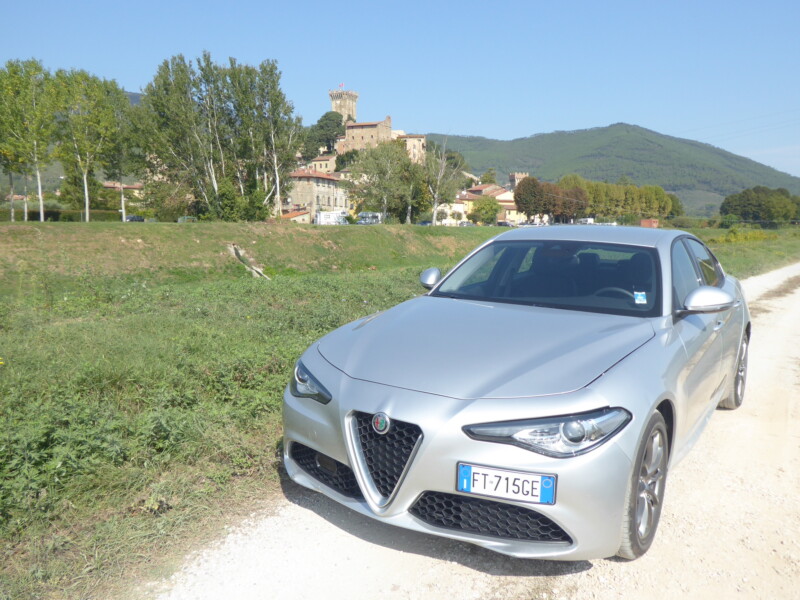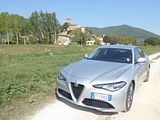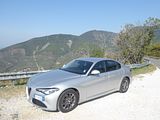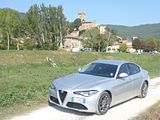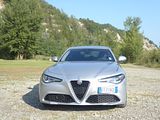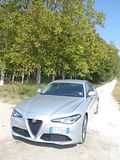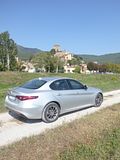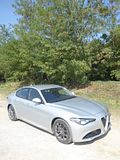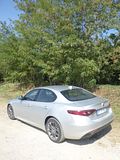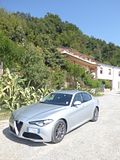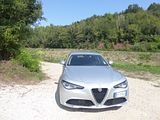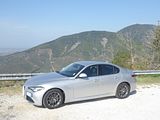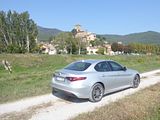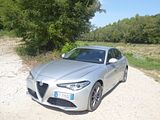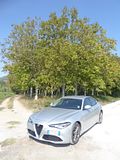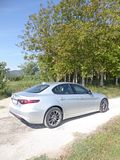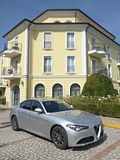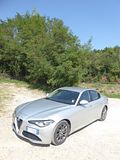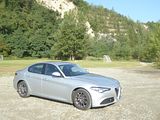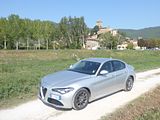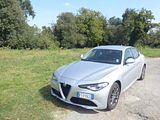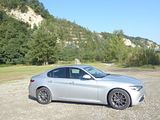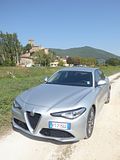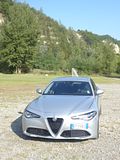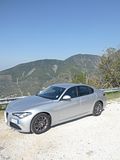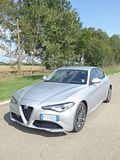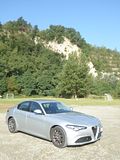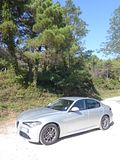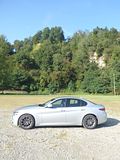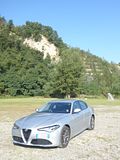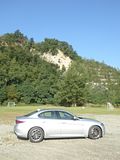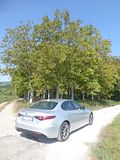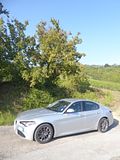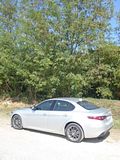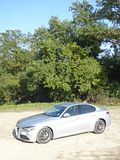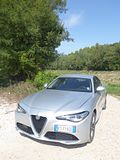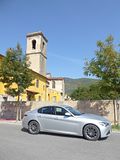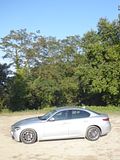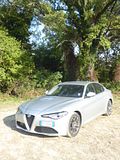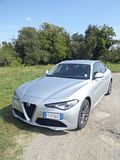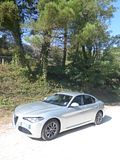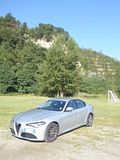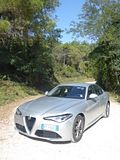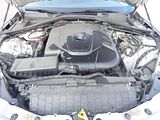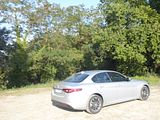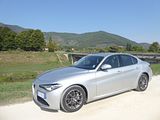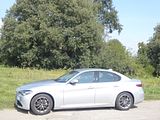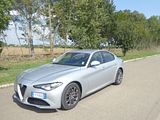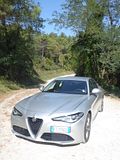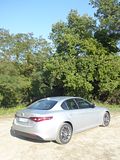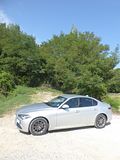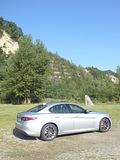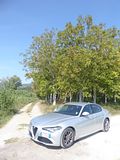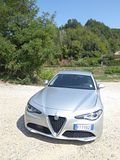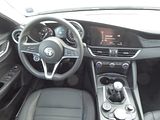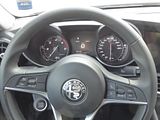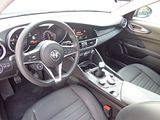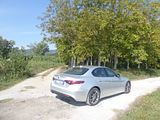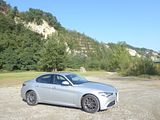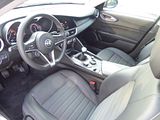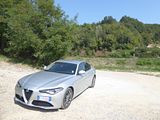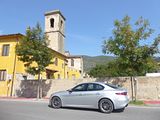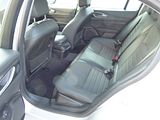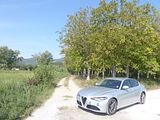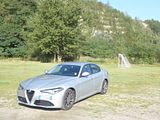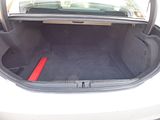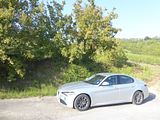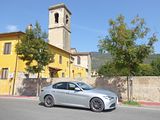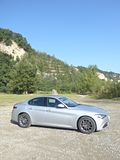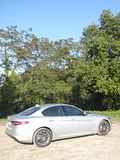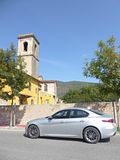My love of Alfa Romeo is well documented. My own motoring history includes three examples of the marque, a 164, a 916 series GTV and a 156 and I loved all three of them. The only reason I moved away from the brand was because at the time I had to select a new company car they simply did not have a product that met my requirements for a large executive saloon, so I ended up with a series of S model Audi as my company car instead, but I kept hoping I could get back to an Alfa at some point. After the 159 faded away, there were growing rumours that there would be a replacement, which was being referred to as the Giulia, and likely to be engineered on a rear wheel drive platform. By early 2012, with my tenure of an Audi S6 nearing its end, the rumours had been circulating widely enough that it seemed like these was some substance behind them, and for a while I was hopeful, but as my decision point got near, it seemed as if a launch was as far away as ever, and so I ordered another Audi, with under the terms of our corporate policy on a 4 year lease. The rumours did not die down, with fairly frequent stories which kept telling us that the Giulia was indeed under development, but the fact that – very unusually in this day and age – no-one had seen a camo-ed up development car out on the roads made us all wonder if it really was coming or not. Finally, with the cars styling perhaps the best kept automotive secret for many a year, the Giulia was finally unveiled to the press at the Museo Storico Alfa Romeo in Arese, on 24 June 2015, at an event which involved only the top-of-the-range Quadrifoglio variant and a rendition of “Nessun dorma” by Italian tenor Andrea Bocelli. The occasion coincided with the company’s 105th anniversary, and also saw the company debut a restyled logo for all future Alfa Romeo models. The Giulia was presented under the new La meccanica delle emozioni slogan (“the mechanics of emotions”) and we were told would be the first model in the company’s relaunch plan, which involved a €5 billion investment for an eight car line-up and a worldwide sales target of 400,000 by 2018. Sadly that plan came and went and Alfa’s model range has been somewhat limited ever since, but the Giulia was definitely here and it did eventually go on sale in the second half of 2016. That was not quite soon enough for me, as I had to order a car for delivery in mid 2016 based on the lease end of my Audi, and anyway, I had now been seduced by another Italian car, a Maserati. First deliveries of the Giulia in the UK were in early 2017 and unusually, rather than starting with the cooking models and adding the performance halo car at a later date, the top of the range Quadrifoglio was part of the range from the outset. Inevitably, it got the majority of the press coverage, almost all of which was effusive beyond anyone’s wildest dreams. In the first few months, the Quadrifoglio captured around 50% of all UK Giulia sales. This elegant looking rear wheel drive saloon may have reviewed well, and people loved its looks, but when they went to their Alfa dealer, having driven it and still loving it, they were not buying it at the rate you might have expected. The problem seemed to be the finance rates with Alfa not able to get close to the very aggressive finance deals that BMW, Mercedes and Audi can offer. So sales were slow, mostly to Alfa enthusiasts, like me, and they have remained that way in the UK proving that it takes more than a great looking car that is fun to drive to break the German dominance of this market sector.
Having driven a Giulia Quadrifoglio in Switzerland in 2018, I was even more eager to sample models from lower down the range, for fairly obvious reasons. Whilst the Quadrifoglio is really impressive, clearly if Alfa is to make its mark in the highly competitive premium saloon market segment, it is going to be with versions that sell in much greater numbers from lower down the range, just as all the main rivals have found, where 2 litre (ish) diesels generate the bulk of the sales. Sourcing one of those versions has not been that easy, though. The most promising route was through Hertz Italia, who have had the Giulia on fleet for a while but in all my trips to Italy whenever I asked even though I did see cars parked up, every one else had had the same idea and they were already allocated so someone else. Spotting that they could now be reserved explicitly when I was booking this September 2020 trip, I did just that, and hoped that the “car guaranteed” promise would actually come true when I arrived at Pisa Airport. Sadly, it did not, as they did not have one, and they gave me a Passat Estate as the next best alternative. They did however promise that if one became available, they would ring me. I honestly did not expect to hear anything, but part way through my week long trip, I did indeed receive a phone call to advise that they had now got a Giulia and that I was welcome to stop by and swap into it. Needless to say, I took advantage of this offer and early the following morning, headed over to Pisa. Hertz have Giulia models with a variety of engines, and this one turned out to be the diesel, and a study of the car’s paperwork revealed that it was actually built in late 2018 and so did not have the changes that have been applied more recently, Indeed, a Giulia of this age is a pre Euro 6d car, evident from the fact that the car does not need AdBlue (this came in not long after this car was built), not that this worried me unduly. I was more interested in how the rest of the car came across.
When the Giulia was under development, diesel power was still very much a thing, as this was pre-dieselgate, so Alfa put a strong emphasis on this fuel type in the initial range. They already had a good engine to use, the 2.2 JTD, which was offered with as many as three different levels of power, 136, 150 and 180 PS, though not all markets got the least powerful of these. Although all UK market Giulia models come with an 8 speed automatic gearbox, there was a manual transmission offered on some versions of the car and this is one of them, as that is what I found in my test car. My first impression was that the engine in this car was much nicer than that in the Passat. It is smoother and quieter, and although the on paper figures say that it is no more powerful, as that had been an entry level 150 bhp car and here I also a 150 PS car. To get the best out of the Giulia you do need to use the gears a lot, though, and whilst there is a bit of a clicky feel to the gear change, the lever does slot neatly between the gears, of which there are 6 forward ones. All Giulia models feature three different drive modes: D, N and A – Dynamic, Natural and Advanced efficiency. Selecting D does indeed sharpen up all the responses somewhat, though of course with a manual gearbox you only hang onto the gears longer if you the driver chose to do so. During my time with the Giulia, I covered a total of 705 km and used 42 litres of gasolio (diesel), which computes to 47.63mpg, a decent though not spectacular result.
When the first drives of the Giulia were published, tester after tester expressed utter delight at the way the car drives, with perfectly judged steering, and class-leading handling, road-holding and grip. I found no reason to disagree with any of these assessments. A lot of development effort went into this aspect of the car, and it shows. There is perfect 50/50 weight distribution, whilst the suspension is independent all-around, double wishbones at the front and multilink at the rear. All Giulia models employ a carbon-fibre drive shaft made by Hitachi Automotive Systems, as well as aluminium alloy shock towers and suspension components. This truly is an impressive car to drive and is perhaps at its most enjoyable when punting it down a twisty road, of which there are plenty in Tuscany where I was driving the car. There is lots of feel to the steering, which has fewer turns lock to lock than you will find in most of its rivals. The car corners neatly, and you always get the impression that you could easily have gone faster than you did and the chassis would be well up for the challenge. The Super version of the Giulia comes on 225/50 R17 wheels, and it rides nicely. It is firm but not unduly so, and seemed to be well up to the challenges of the varied surfaces of Tuscan roads. The Giulia features a new Integrated Brake System, an innovative electromechanical system which combines stability control and a traditional servo brake for instantaneous brake response. I certainly found the brakes to be powerful and effective. There is an electronic handbrake, and it generally disengaged smoothly, though as with all these sort of devices, hill starts can be a challenge. There is an Emergency Brake Assist feature among the various safety systems that come on all Giulia models. One slight irritation was the need to put the seat belt on to disengage the parking brake, which is a nuisance when you only want to move the car a few feet. Visibility is about par for the course these days. Rear parking sensors and a camera are available in an option pack, which was not fitted to the test car. The view over the shoulder is not that great, again, not atypical of the latest cars.
The interior of this version of the Giulia is very like that of the Quadrifoglio without all carbon fibre. Plenty to has been written saying that the quality here is not very good, but I really struggle to see what is being complained about and in what ways this car is worse than most of its rivals. There were some changes which were introduced in early 2020, but as the test car was built in late 2018, they did not feature here. You get what looks like a traditional Alfa style dash with two individually deeply recessed hooded dials though of course the graphics are rather more contemporary. There are the fashionable dot-based charts for fuel level and water temperature. The steering wheel boss has buttons for cruise control and repeaters for the audio system. There are twin column stalks, with a one touch operation, which always strikes me as the solution to something that was never a problem. The centre of the dash contains a small 6.6” integrated colour screen which on this version of the Giulia was needed primarily for the audio system as there was no navigation installed. It is nothing like as sophisticated a set-up as you will find in some of the Giulia’s rivals, which in my opinion may not necessarily be that bad a thing. There is a turn wheel in the centre console to operate some the functions, as slightly surprisingly, the screen itself does not have a touch function. The centre console also has the DNA switch which changes the driving modes as has been the way on Alfa models for a few years now. There is dual zone climate control, which was a bit noisy in operation but effective at cooling the cabin.
Seat upholstery in this Super model was part leather. There is plenty of adjustment available, all of which is manual in this version of the car. The natural driving position is quite low, so you do feel that you are sitting in the car, sports-car style, which I rather liked. The steering column adjusts in/out and up/down. The seat itself proved very supportive and comfortable.
The rear seats are a bit on the tight side. The central tunnel is quite wide, so it is probably best to think of the Giulia as a four seater, at least where adults are concerned. Headroom is not an issue. In this version, the seats are fixed, with no provision to fold them down for extra luggage capacity. There are nets on the back of the front seats and small door pockets for odds and ends.
The boot is long but not that deep, so although the quoted capacity is class competitive, you may find that things don’t fit in quite the way you would hope. There is a compressor under the boot floor, as opposed to a spare wheel, and this occupies all the available space so there is no room for any bits and pieces here. The rear seats are fixed, so you won’t be able to get extra long things in. Inside the cabin, there are all the usual things: a modestly sized glovebox, pockets on the doors and a central armrest cubby.
At launch, as well as the potent Quadrifoglio model, there was a choice of two or three (depending on market) 2.2 JTD-m2 diesels (136, 150 and 180PS) and a single 2.0 petrol with 200PS. Trim levels were an entry car, Super and Speciale as well as the Quadrifoglio. The base model comes with 16in alloy wheels, cruise control, rear parking sensors, a chrome exhaust pipe, LED rear lights and a wealth of safety technology – including that autonomous emergency braking, lane departure warning and forward collision warning – as standard. Inside there are manually adjustable front seats, a leather-clad steering wheel, dual-zone climate control, automatic wipers and lights, and Alfa’s infotainment system complete with a 6.5in display, a DAB radio, and USB and Bluetooth connectivity. Moving up through the range to the Super adds part-leather trim, an 18.8-inch display and 17-inch wheels with a dual chrome exhaust tip for the diesel model. The Speciale models include 18-inch alloys, black brake calipers, xenon headlights, electrically adjustable heated leather front sports seats, a heated steering wheel and washer jets, along with sportier trim inside and out and folding rear seats. During 2017 a 280PS petrol engine Veloce joined the range. The Veloce has specific bumpers and a glossy black door trim; it has also various performance components like special rear extractor with double exhaust pipes and optional 5-spoke 19-inch alloy wheels (the 19-inch option is not available in the UK). On the interior, it has black, red or tan leather sport seats and a sports steering wheel with a suede grip, aluminium inserts on the dashboard, central tunnel, door panels and Xenon headlights. From August 2018 there was a higher-spec Veloce Ti with many of the Quadrifoglio’s features, such as 19-inch wheels, leather/Alcantara heated sports seats and carbon interior trim. Changes since then have seen the adoption of a new 8.8” colour touchscreen across the range, upgraded quality to many of the interior fittings, a tweaking of the model range with new trim versions and some minor cosmetic changes as well as an additional 10PS of power for the diesel engines.
I thoroughly enjoyed my time with the Giulia. Although not like as fast as the Quadrifoglio, you do have to remember that in this guise, it only costs around half as much to buy and will also cost an awful lot less to run. For someone doing a lot of miles, the diesel engine still makes sense, especially as it is a good unit, both smooth and torquey. The rest of the car has huge appeal, too, from the way it looks to the way it drives. For sure the rear passenger space is not quite as generous as in the German rivals, but it does beat the Jaguar XE, another car in this class that I rather like, and whilst the interior finish may not be quite up to Audi levels, there is nothing wrong with it. Were I looking for a slightly smaller and cheaper car than my Maserati, I am absolutely convinced that a Giulia would be the car I would pick. The only thing that would need more research is which version, as I suspect that the real everyday star of he range is going to be the 280 PS Veloce. Now I need to see if I can source one of those.

